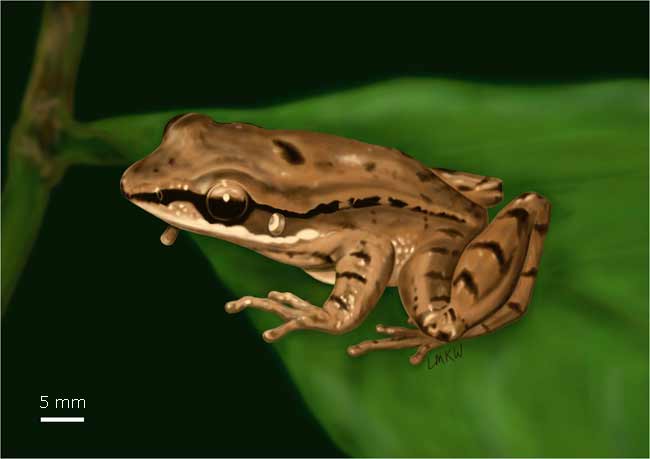Frogs Go Ultrasonic for Sex

Keep the racket down, I’m trying to find a mate! That could be the plea of nocturnal Chinese tree frogs, which have developed unique, high-frequency vocal skills to make themselves heard by potential mates in their noisy habitat.
The frogs' sounds are no mere "ribbits," but ultrasound squeaks designed to be heard over the rushing of a nearby mountain river that roars in the audible sound range.
"The background noise covers the entire human hearing range," said Peter Narins, a biologist at the University of California, Los Angeles. "Just talking to my colleagues there, you really have to raise your voice to be heard. We think these animals are under evolutionary pressure to avoid that channel and go above it."
The ultrasonic creatures, known as torrent frogs (Odorrana tormota), live near China's Yellow Mountain. They are tiny brown- and black-striped critters, less than one and a half inches (35 mm) across. Whereas most frogs chirp in the audible sound range, this species is one of only a few that produce higher-frequency ultrasound noises.
The noises are mainly courtship calls. Males cry out to advertise their virility, and females squeak just before they ovulate to announce their fertility.
Here, froggy froggy!
Narins and his colleagues, led by Jun-Xian Shen of the Chinese Academy of Sciences in Beijing, recorded the squeaks of female Odorrana frogs using an ultrasonic microphone. When the researchers played back the females' sounds, male frogs would call out and hop toward the speakers.
Get the world’s most fascinating discoveries delivered straight to your inbox.
The scientists found that the eager male frogs could pinpoint where the females' noises were coming from with an extraordinary degree of precision.
"From a meter away you can play the sound of a female, and in some cases, in one leap the males jump right to the center of the sound," Narins told LiveScience. "Their precision was remarkable — it rivals that of the best vertebrate performers, such as barn owls, dolphins and humans."
Male Odorrana frogs can locate the source of a female's mating call to within about one degree on average. In contrast, most other amphibians can only pinpoint sound to within 16 to 23 degrees, Narins said.
Sound shadow
The key to these frogs' amazing abilities lies in the fact that they produce their calls in ultrasound, which has shorter wavelengths than audible sound.
Animals compare the intensity of the sound signals received by their two ears to localize where a sound is coming from. For this reason, the size ratio of the animal's head compared to the wavelength of the sound is important: If the sound waves are much smaller than the head, many waves get bounced off and the signal coming to one ear is much stronger than to the other. This large differential, called a sound shadow, helps the animal locate the noise's origin.
However, if the sound waves are larger than the head, they can reach the ear on the other side without getting bounced off, so the two ears receive comparable signals, making it difficult to distinguish where the noise is coming from.
Working with Nature
By chirping in frequencies above the audible din of nature, the frogs have found an ingenious solution to their environmental predicament.
"If you have a really noisy environment you have to figure out how to overcome it," Narins said. "That's how nature works. You have to be adapted as well as possible to your environment. They figured out how to do it very well."
The researchers detailed their findings in the May 11 issue of the journal Nature. The study was funded by the National Natural Sciences Foundation of China, U.S. National Institute on Deafness and Other Communication Disorders, UCLA Academic Senate, Paul S. Veneklasen Research Foundation, and U.S. National Science Foundation.



